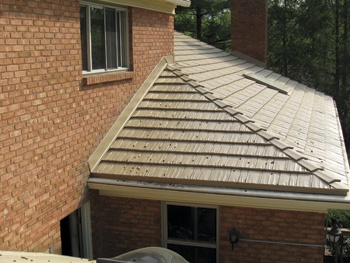Dear Jim: I need to replace my shingle roof, and I heard metal roofs qualify for an energy-efficiency tax credit. How does a metal roof conserve energy? Are they worth the additional cost? —Robert K.
Dear Robert: Many—but not all—metal roofs qualify for the federal energy-conservation tax credit for 2010. Metal roofs save energy by reflecting heat, keeping your house cooler during the summer. That can dramatically improve comfort inside and reduce electric bills if your home is air-conditioned. During the winter, a metal roof has a negligible effect on the energy efficiency of your house.
In general, to qualify for the energy tax credit the roof must meet Energy Star qualification standards. For roofing, this means the TSR (total solar reflectivity) must be greater than 25 percent when new and 15 percent after three years. To be sure that the roofing qualifies, ask for the specifications and a manufacturer’s certification statement (MCS). It pays to be diligent: I recently got quotes
on a roof installation, and several roofers told me their asphalt shingles qualified for the tax credit. In actuality, they did not qualify.
The amount of the tax credit is 30 percent of the material cost of the roof (not installation expenses) up to a maximum of $1,500. Use IRS Form 5695 to apply for the tax credit and save the payment receipt and MCS in case of a tax audit.
For my own home project, I eventually selected a Classic Metal Roofing Systems aluminum roof. It is made from 98 percent recycled aluminum, and the 1-by-2-foot panels are formed to simulate a cedar shake roof. It’s attractive and certainly unique: Many neighbors were stumped trying to figure out exactly what it is.
Although it is more expensive to install than an asphalt shingle roof, my new metal roof will never have to be replaced. From a lifetime cost comparison, it is cheaper than installing an asphalt roof every 20 to 30 years. I also get a 3 percent reduction on my homeowner’s insurance because of reduced fire hazard.
Most metal roofs reflect more of the sun’s heat than do asphalt shingles, particularly black shingles. My Classic metal roof has a TSR of 0.43, whereas a black asphalt shingle roof has a TSR of only 0.05. This keeps the roofing materials cooler so less heat is radiated down through the ceilings to the living area. Also, the underside of the aluminum metal surface has lower “emissivity” (the ability to emit heat) than shingles, so even less heat radiates downward.
It was warm, sunny weather when my metal roof and ridge vent were installed, and the second floor was noticeably cooler than before.
The final energy advantage is that the Classic Metal Roofing aluminum panels are relatively thin with the contour of shakes formed into them. This contour creates an air gap between most of the roofing and the roof sheathing or shingles below it. This gap allows some outdoor air to naturally circulate up under the metal roof panels to keep them cooler. I sealed off my gable vents so outdoor air is now drawn in the soffit vents and exhausted out the ridge vent.
One minor drawback to the aluminum shake panels is they can dent if you indiscriminately walk on the high points of the contour. This can be avoided by stepping on the lower nailed area of the panels. Contoured insulating foam pieces were placed under areas of panels to provide walkways on the roof to clean my skylight and service the ridge vents.
Steel roofing is another option becoming more popular on homes. Painted standing seam or tile steel roofing is very durable. Instead of trying to simulate some type of standard roofing material, the bright colors and unique appearance are signatures of upscale homes. The finish coating on aluminum and steel often uses a Kynar-based paint with heat reflecting additives in a multistep process.
——————–
James Dulley writes a regular syndicated column about energy efficiency for homeowners. Contact him at [email protected].

